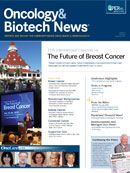Publication
Article
Oncology & Biotech News
Biomarker Predicts Survival Benefit in Advanced Kidney Cancer Treated With TORC1 Inhibitor
Author(s):
Pretreatment serum lactate dehydrogenase is a prognostic factor in poor-risk patients with renal cell carcinoma and also a predictive factor for a survival benefit from treatment with temsirolimus.
Andrew J. Armstrong, MD
Pretreatment serum lactate dehydrogenase (LDH) is a prognostic factor in poor-risk patients with renal cell carcinoma (RCC), and also a predictive factor for a survival benefit from treatment with the target-of-rapamycin complex 1 (TORC1) inhibitor temsirolimus, according to Andrew J. Armstrong, MD, and coauthors of a restrospective analysis.
Armstrong, an assistant professor of Medicine and Surgery at Duke University Medical Center in Durham, North Carolina, and colleagues evaluated pretreatment and posttreatment serum LDH in 404 patients with stage IV or recurrent RCC and at least three of six prespecified prognostic factors for short survival who received temsirolimus or interferon alfa as part of a randomized phase III trial.
The investigators aimed to determine whether serum LDH is prognostic and has predictive value in patients with advanced RCC receiving a TORC1 inhibitor.
LDH is a metabolic enzyme that is involved in anaerobic glycolysis and is regulated by the phosphatidylinositol 3-kinase/Akt/mammalian target of rapamycin (mTOR)-containing complex 1 (PI3K/Akt/TORC1) pathway, as well as tumor hypoxia/necrosis. High serum LDH levels have been linked to poor prognosis in several malignancies, including RCC.
The mean baseline normalized LDH in the study population was 1.23 times the upper limit of normal (ULN; range, 0.05-28.5 × ULN).
The multivariable hazard ratio for death was 2.81 (95% CI, 2.01-3.94; P < .001) for patients with LDH >1 × ULN versus patients with LDH ≤ 1 × ULN.
The LDH-treatment interaction term was statistically significant for overall survival (OS; P = .016).
In 140 patients with LDH exceeding the ULN at baseline, median OS was 6.9 months for patients treated with temsirolimus versus 4.2 months for patients treated with interferon alfa (P = .002).
Patients with low baseline LDH did not experience a clear OS benefit. In 264 patients with low baseline LDH, the median OS time was 11.7 months for the temsirolimus group, compared with 10.4 months for individuals who received interferon alfa (P = .51).
Armstrong et al identified numerous strengths of their investigation, including the large sample size, prospective compilation of data and treatment, random allocation of patients to treatment, favorable OS outcomes with temsirolimus over interferon alfa, and the inclusion of multiple established prognostic factors in multivariable analysis.
They emphasized, however, that their analysis included only poor-risk patients with RCC as defined by a composite scoring system. Thus, the results cannot be reliably extrapolated to intermediate-risk patients with high LDH.
The researchers also noted that their analysis compared temsirolimus with interferon alfa, a therapeutic regimen that is no longer widely used. Thus, large comparative studies are needed to determine whether LDH is a predictive factor for the benefit of TORC1 inhibition over other drugs, such as sorafenib (Nexavar), sunitinib (Sutent), or bevacizumab (Avastin).
Armstrong AJ, George DJ, Halabi S. Serum lactate dehydrogenase predicts for overall survival benefit in patients with metastatic renal cell carcinoma treated with inhibition of mammalian target of rapamycin [published online ahead of print August 13, 2012]. J Clin Oncol. doi:10.1200/JCO.2011.40.9631.









